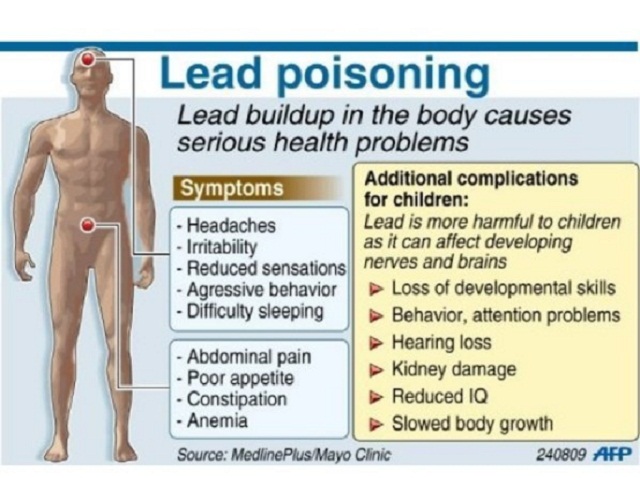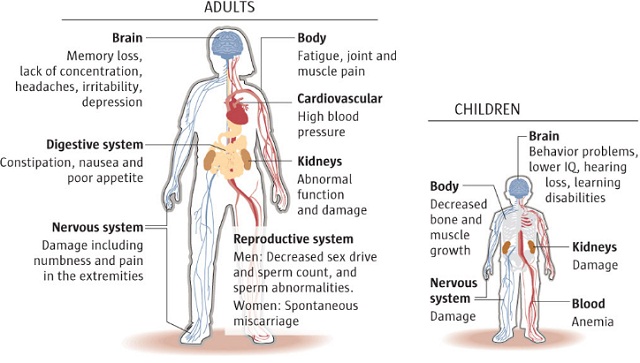
Nairobi, Kenya | AFP | Irene Akinyi Odinga has lead poisoning. With no money for treatment, the young mother of two stares death in the face.
“I feel very bad,” the 25-year-old tells AFP on the sidelines of a UN pollution conference, shivering in a thick jacket in the warm Kenyan sun.
“I have constant headaches. I cannot walk long distances, I can’t even cook for my own children.”
Odinga is one of dozens of inhabitants of the Owino Uhuru slum near Mombasa, Kenya’s second-largest city, who say they were poisoned by a plant recycling lead-acid batteries, the type used in cars.
“My father, my brother, my husband all worked at the smelter,” Odinga says. “I washed their (work) clothes.” She suspects this is how the lead got in her system.
Addressing the scourge of lead pollution, a health hazard particularly in poor and middle-income countries, was a focus of the UN Environment Assembly (UNEA) held in the Kenyan capital Nairobi this week.
On Wednesday, environment ministers adopted a resolution expressing concern about the health and environmental impacts of lead-acid battery recycling.
“Exposure to lead, including lead in paint and in waste lead-acid batteries, can cause serious lifelong damage, especially in children, such as loss of IQ and behavioural problems,” it said.
– Everything changed –
“Exposure of pregnant women to high levels of lead can cause miscarriage, stillbirth as well as malformations,” the resolution noted.
Lead exposure is estimated to cause nearly half a million deaths each year, according to the World Health Organization.
It accounts for more than one in ten cases of intellectual disability, 2.5 percent of global heart disease, and about the same percentage of strokes.
Phyllis Omido worked at the Owino Uhuru battery recycling plant about seven years ago.
A single mother with no daycare options, she brought her infant son, still breastfeeding, to work with her.
After about two months, the boy, Kingdavid Jeremiah Indiatsi, fell ill.
“My son had been a very easy baby from birth, he would sleep the whole night. My neighbours would always tease me: ‘Are you sure you’ve got a baby?’ because he was always very silent.
“But then suddenly he was screaming the whole night… He had fevers that were not breaking. Then he started (having) diarrhoea. Suddenly he was not able to eat. After some time he got very dehydrated. He was severely anaemic.”

After months in and out of hospital, and tests for diseases such as malaria and typhoid, Kingdavid tested positive for lead poisoning.
The diagnosis launched Omido into a years-long campaign to get the government, which licenced the plant, and company bosses to close the smelter and clean up the environment.
The plant was finally shuttered in 2014 — too late for many in the community of some 3,000 people.
– ‘Just breaks my heart’ –
More than 150 community members and 22 smelter workers have tested positive for lead poisoning so far, Omido told AFP at the UNEA, which she attended as a delegate.
Dozens have died, many of them babies.
Without access to chelation therapy, which removes heavy metals from the body, Kingdavid’s lead levels were reduced through years of treatment with calcium and zinc, thought to displace lead in blood, his mother said.
But the boy’s future is uncertain.
“The doctors advised me that he has to go for an (IQ) evaluation because lead affects the IQ.
“I’ve not taken him for that, because it just breaks my heart and I fear that if we tell him: ‘This thing has affected your IQ’ he might see himself like he’s less than other children.”
Kingdavid struggles with concentration, said Omido, who funded the Center for Justice Governance and Environmental Action as part of her campaign, and has been awarded the prestigious Goldman Environmental Prize.
“He has many friends, and you can see a clear difference. He doesn’t react as fast as other kids and… he can’t concentrate on you for a very long time.
“We have to do a lot of extra tuition for him. When his friends are on holiday, he still has to catch up.”
The UNEA resolution adopted on Wednesday expressed “strong determination” to reduce exposure to lead, “including through promoting environmentally sound management of waste lead-acid batteries and eliminating lead paint.”
Omido also worries for her friend, Odinga, whom she brought to the assembly to highlight her plight.
“I’m very surprised and thankful to God that Irene is still alive,” Omido said. “But I’m afraid that if we do not act… she’s going to die as well. We need to get chelation medicine for her.”
Of all the smelter workers tested so far, Omido is the only one with a manageably low lead poisoning level.
“I was really surprised. And happy,” she laughs.
“I was so sure that I had it. I guess (it’s) also because I was working in the office and not in the furnace. Most of the people who have died were the ones that were working directly in the furnace.”
 The Independent Uganda: You get the Truth we Pay the Price
The Independent Uganda: You get the Truth we Pay the Price



